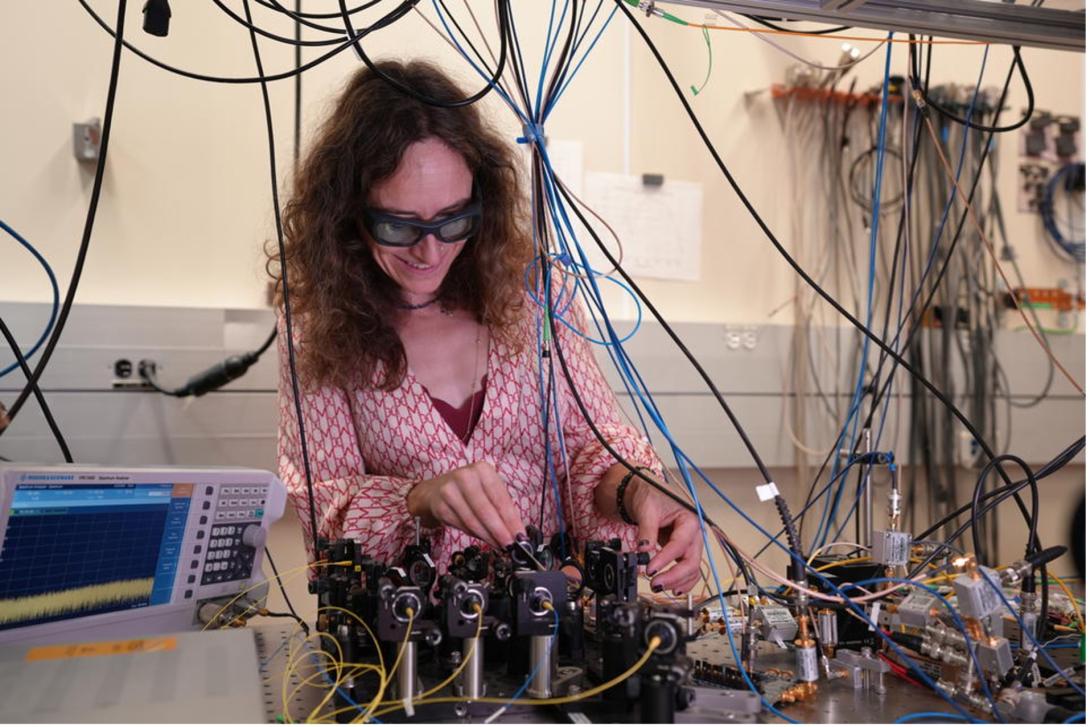Researchers Reinvent Laser Technology
Team members at the National Institute of Standards and Technology (NIST) are improving their innovative laser-equipped technology. The new free-form dual-comb spectroscopy, a novel method for measuring gases, may help in several ways such as detecting poisonous gases on the battlefield and preventing gas leaks from becoming more severe, but researchers acknowledge that the technology is not perfect.
The first improvement team members are looking to make is related to the system’s size. Scientists built the tool indoors as a lab system; therefore, it is massive and extremely hard to break down and move anywhere. Because of this, it is difficult for team members to move it outside and use it to its full potential, according to Esther Baumann, research scientist at NIST. Baumann wants to work on making the technology smaller to work in more than just the lab setting.
“Shrinking it is always something we must drive, so we can get it outside and do field measurements,” Baumann said. “More detailed field measurements where we say, ‘OK, we want to really home in on this specific ask; we want to do that measurement or whatsoever.’”
Next, crew members are working toward adding more applications that will allow the free-form dual-comb spectroscopy to perform even more measurements. The additional applications could help the tool conduct more “sciency” measurements, according to Baumann.
Additionally, team officials want to see how the laser works at longer wavelengths. The tool performed really well in its testing spot near-infrared wavelengths. In the next steps, NIST personnel will move the tool further away and into the “mid-infrared” area, according to Dr. Ian Coddington, group leader for NIST’s Fiber Sources and Applications Group. Accomplishing this will expose the tool to a higher sensitivity to different trace species in the atmosphere.
Another benefit of adding this feature is that the tool would have the ability to recognize large molecules in addition to the small, finer molecules that it can detect now. For example, methane is easily detectable with the free-form dual-comb spectroscopy, but the tool is unable to identify chemicals associated with weapons of mass destruction, according to Coddington. To address this, team members want to make the technology more versatile and useful in military operations.
“You would actually want to see the chemical at a concentration that’s going to give you a chance to warn people that it’s coming before it’s lethal; you want a very high sensitivity,” Coddington said. “Then you want to take advantage of this technique that [team members] came up with where you’re only sampling; you’re only looking where there’s a lot of information content.”
“You get a lot of sensitivity enhancements from there, but you get an additional sensitivity enhancement if you were to go through these longer wavelengths, and applying both those hammers simultaneously maybe puts you in a much more interesting spot,” Coddington added.
Lastly, Baumann and her colleagues are trying to apply this laser-based technology to the medical field. She says she wants to use the lasers to make it easier for doctors to conduct muscle testing. Currently, doctors must cut the skin and take a sample of a muscle to analyze it, but Baumann envisions that doctors could use this new laser technique to examine muscles and use coloration to see which parts are healthy and which are unhealthy. Similar to an X-ray, these lasers could give you an in-depth look at what is going on within someone’s body without making any incisions, according to Baumann.
As aforementioned, the free-form dual-comb spectroscopy technique is new and has already shown enormous potential.
Scientists can now identify and detect materials and gases at a higher rate. The lab-based system proved to be able to recognize a single gas with a “22 times higher sensitivity than a traditional dual-comb system,” according to NIST officials. If applied in the real world, the tool could alert people of small gas leaks or emissions, allowing scientists to address the problem swiftly. The technique allows scientists to develop a kind of blueprint of gases that are not visible to the naked eye. This allows scientists to see where the gas leak is taking place so they can quickly go in and fix the issue, according to NIST officials. Prior to the development of the free-form dual-comb spectroscopy, harmful gases could leak and, in turn, destroy the environment without anyone knowing. This new technique helps prevent that from happening.
These images have also given scientists the ability to perform compressive sampling. Since researchers can now see the “invisible” gases, they can plan and conduct their tests significantly more quickly and efficiently, according to NIST officials. In other words, scientists can now test only in areas where they see the gas clouds, instead of wasting time and money testing each place blindly.
“To just extract signal where you have the most information, that is something that we really try to apply with this free-form dual-comb platform,” Baumann said. “Kind of concentrate on ‘OK, I want to measure this specific one, and I don’t care about the rest; then you can fine-tune our free-form dual-comb platform to only measure this one.’ Sure, you need some prior knowledge and other things, but you could not have done that before.”
“We really are dynamically controlling these electric fields at the attosecond level, and you’re doing it specifically so you can look where you know the information is supposed to be,” Coddington added.
The free-form dual-comb spectroscopy idea evolved from the optical frequency comb system. This laser-based platform “produces light at a series of equally spaced, precise frequencies that resemble the teeth of a comb,” according to NIST officials. These base-level lasers were created about 20 years ago with an initial goal of creating precise clocks. The original platform contained a broad-spectrum laser, and after its release, researchers realized that its broad-spectrum laser could benefit the science community in more than one way, such as locating and visualizing greenhouse gases.
As aforementioned, the technology is still only made for the lab, but officials with several groups within the Defense Advanced Research Projects Agency’s (DARPA’s) SCOUT and SIGMA+ programs are already expressing interest in using the technology to identify dangerous gases and chemicals, like mustard gas and sarin gas.
“I think in DARPA, they’re envisioning what happens if a bad actor got ahold of a truckload of fluoride and tried to create some sort of bomb out of that,” Coddington said. “Could you detect those things? And [they’re] also [asking] questions like, ‘If you’re looking down the line at the meth lab, could you pick up some of those secondary chemicals that are being generated and maybe identify the possibility that there’s something nasty or illicit happening in this location?’ And also, of course, being able to separate that from somebody who’s just running a nail salon.”
“The spectroscopy gives you a lot of information about the species that are potentially coming out of a lot of these areas,” Coddington added. “That said, all of this is still in the early stages.”





Comments